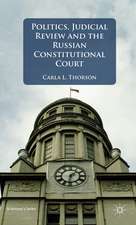Atlas of Crime: Mapping the Criminal Landscape
Autor Borden D. Dent, Elaine H. Hendrix, Linda S. Turnbullen Limba Engleză Hardback – 10 oct 2000 – vârsta până la 17 ani
Preț: 355.51 lei
Preț vechi: 712.81 lei
-50% Nou
Puncte Express: 533
Preț estimativ în valută:
68.04€ • 70.77$ • 56.17£
68.04€ • 70.77$ • 56.17£
Carte tipărită la comandă
Livrare economică 15-29 aprilie
Preluare comenzi: 021 569.72.76
Specificații
ISBN-13: 9781573562416
ISBN-10: 1573562416
Pagini: 224
Ilustrații: 1, black & white illustrations
Dimensiuni: 216 x 279 x 24 mm
Greutate: 1 kg
Editura: Bloomsbury Publishing
Colecția Greenwood
Locul publicării:New York, United States
ISBN-10: 1573562416
Pagini: 224
Ilustrații: 1, black & white illustrations
Dimensiuni: 216 x 279 x 24 mm
Greutate: 1 kg
Editura: Bloomsbury Publishing
Colecția Greenwood
Locul publicării:New York, United States
Notă biografică
Linda S. Turnbull is completing her PhD in sociology at Georgia State University with a specialization in criminal and deviant behavior. Elaine Hallisey Hendrix is the geographic information systems research coordinator in the Department of Anthropology and Geography at Georgia State University. Borden D. Dent is professor emeritus of geography in the Department of Anthropology and Geography at Georgia State University.
Cuprins
List of Figures and TablesContributorsPrefaceAcknowledgmentsCartography in the Atlas of Crime by Elaine Hallisey HendrixGeographic History of CrimeBrief History of Crime Mapping by Borden D. DentCrimes of Personal ViolenceHomicide by Keith HarriesAssault by Jose Javier LopezRape in the United States by Kathleen C. BasileRobbery by Doug WilliamsonCrimes Against PropertyBurglary by Susan M. WalcottAuto Theft and Detecting Chop Shop Locations by Nancy G. La Vigne, Jill Kathleen Fleury, and Joseph SzakasEnvironmental Crime by Nancy L. Winter and Ute J. DymonConfronting Computer Crimes by John Jarvis and Gordon R. WynnFamily ViolenceIntimate Violence by Denise A. DonnellyThe Spatial Dimensions of Child Abuse and Neglect by Linda S. TurnbullElder Abuse by Denise A. DonnellyAnimal Cruelty: A Spatial Investigation by Linda S. TurnbullOrganized and Entrepreneurial CrimesMapping the Set Space of Urban Street Gangs by George E. TitaThe Spatial Dynamics of Drug Trafficking by Linda S. TurnbullProstitution by Jacqueline BolesModern Maritime Piracy by George J. Demko"Film at 11 Crimes"Serial Murder in the United States, 1860-1995 by Christopher G. MissenDomestic Terrorism by Damon D. CampHate Crimes by Damon D. CampSchool Violence by Pamela Riley and Joanne McDanielMental MappingCriminals' Mental Maps by David Canter and Samantha HodgeCognitive Maps and the Fear of Crime by Patricia GilmartinMaps in Detective Fiction by Leslie EdwardsCriminal JusticeA Spatial Analysis of American Police Killed in the Line of Duty by Robert J. Kaminski, Eric S. Jefferis, and Chanchalat ChanhatasilpaThe Concept of Community Policing and a Case Study of Lima, Ohio by William V. AckermanCrime Scene Sketch by W. Jerry ChisumPolice Department Use of Geographic Information Systems for Crime Analysis by Elaine Hallisey HenrixCapital Punishment by Keith HarriesIndex
Recenzii
[M]apping is an excellent way of studying crime, making this study extremely beneficial for sociologists and criminologists. Highly recommended.
[A] very useful addition to library collections, for information about spatial aspects of criminal activities, and to personal libraries for cartographers, to provide information on methods of depicting crime.
Readers can recognize that maps can enrich their understanding of crime and its control on several different levels. The contributors to this volume have solid credentials and, altogther, Atlas of Crime provides its readers with some rich insights in the character and distribution of crime in the United States.
This fascinating look at how law enforcement uses information to combat crime is actually intended for college and public libraries, but schools with special law or geography-related curricula will find it a useful addition to their collections.
Attention, crime buffs! This reference work will show you where to go to find (or avoid) any type of criminal activity. . . . I recommend that every criminal justice practitioner, urbanologist, and sociologist have this book.
[A] very useful addition to library collections, for information about spatial aspects of criminal activities, and to personal libraries for cartographers, to provide information on methods of depicting crime.
Readers can recognize that maps can enrich their understanding of crime and its control on several different levels. The contributors to this volume have solid credentials and, altogther, Atlas of Crime provides its readers with some rich insights in the character and distribution of crime in the United States.
This fascinating look at how law enforcement uses information to combat crime is actually intended for college and public libraries, but schools with special law or geography-related curricula will find it a useful addition to their collections.
Attention, crime buffs! This reference work will show you where to go to find (or avoid) any type of criminal activity. . . . I recommend that every criminal justice practitioner, urbanologist, and sociologist have this book.









